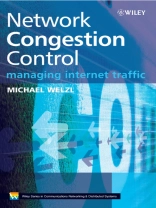As the Internet becomes increasingly heterogeneous, the issue of
congestion control becomes ever more important.
In order to maintain good network performance, mechanisms must
be provided to prevent the network from being congested for any
significant period of time. Michael Welzl describes the background
and concepts of Internet congestion control, in an accessible and
easily comprehensible format. Throughout the book, not just the
how, but the why of complex technologies including the Transmission
Control Protocol (TCP) and Active Queue Management are explained.
The text also gives an overview of the state-of-the-art in
congestion control research and an insight into the future.
Network Congestion Control:
* Presents comprehensive, easy-to-read documentation on the
advanced topic of congestion control without heavy maths.
* Aims to give a thorough understanding of the evolution of
Internet congestion control: how TCP works, why it works the way it
does, and why some congestion control concepts failed for the
Internet.
* Explains the Chiu/Jain vector diagrams and introduces a new
method of using these diagrams for analysis, teaching &
design.
* Elaborates on how the theory of congestion control impacts on
the practicalities of service delivery.
* Includes an appendix with examples/problems to assist
learning.
* Provides an accompanying website with Java tools for teaching
congestion control, as well as examples, links to code and
projects/bibliography.
This invaluable text will provide academics and researchers in
computer science, electrical engineering and communications
networking, as well as students on advanced networking and Internet
courses, with a thorough understanding of the current state and
future evolution of Internet congestion control. Network
administrators and Internet service and applications providers will
also find Network Congestion Control a comprehensive,
accessible self-teach tool.
congestion control becomes ever more important.
In order to maintain good network performance, mechanisms must
be provided to prevent the network from being congested for any
significant period of time. Michael Welzl describes the background
and concepts of Internet congestion control, in an accessible and
easily comprehensible format. Throughout the book, not just the
how, but the why of complex technologies including the Transmission
Control Protocol (TCP) and Active Queue Management are explained.
The text also gives an overview of the state-of-the-art in
congestion control research and an insight into the future.
Network Congestion Control:
* Presents comprehensive, easy-to-read documentation on the
advanced topic of congestion control without heavy maths.
* Aims to give a thorough understanding of the evolution of
Internet congestion control: how TCP works, why it works the way it
does, and why some congestion control concepts failed for the
Internet.
* Explains the Chiu/Jain vector diagrams and introduces a new
method of using these diagrams for analysis, teaching &
design.
* Elaborates on how the theory of congestion control impacts on
the practicalities of service delivery.
* Includes an appendix with examples/problems to assist
learning.
* Provides an accompanying website with Java tools for teaching
congestion control, as well as examples, links to code and
projects/bibliography.
This invaluable text will provide academics and researchers in
computer science, electrical engineering and communications
networking, as well as students on advanced networking and Internet
courses, with a thorough understanding of the current state and
future evolution of Internet congestion control. Network
administrators and Internet service and applications providers will
also find Network Congestion Control a comprehensive,
accessible self-teach tool.
Table of Content
Foreword.Preface.
List of Tables.
List of Figures.
1. Introduction .
1.1 Who should read this book?
1.2 Contents.
1.3 Structure.
2. Congestion control principles.
2.1 What is congestion?
2.2 Congestion collapse.
2.3 Controlling congestion: design considerations.
2.4 Implicit feedback.
2.5 Source behaviour with binary feedback.
2.6 Stability.
2.7 Rate-based versus window-based control.
2.8 RTT estimation.
2.9 Traffic phase effects.
2.10 Queue management.
2.11 Scalability.
2.12 Explicit feedback.
2.13 Special environments.
2.14 Congestion control and OSI layers.
2.15 Multicast congestion control.
2.16 Incentive issues.
2.17 Fairness.
2.18 Conclusion.
3. Present technology.
3.1 Introducing TCP.
3.2 TCP window management.
3.3 TCP RTO calculation.
3.4 TCP congestion control and reliability.
3.5 Concluding remarks about TCP.
3.6 The Stream Control Transmission Protocol (SCTP).
3.7 Random Early Detection (RED).
3.8 The ATM’Available Bit Rate’ service.
4. Experimental enhancements.
4.1 Ensuring appropriate TCP behaviour.
4.2 Maintaining congestion state.
4.3 Transparent TCP improvements.
4.4 Enhancing active queue management.
4.5 Congestion control for multimedia applications.
4.6 Better-than-TCP congestion control.
4.7 Congestion control in special environments.
5. Internet traffic management – the ISP
perspective.
5.1 The nature of Internet traffic.
5.2 Traffic engineering.
5.3 Quality of Service (Qo S).
5.4 Putting it all together.
6. The future of Internet congestion control.
6.1 Small deltas or big ideas?
6.2 Incentive issues.
6.3 Tailor-made congestion control.
Appendix A: Teaching congestion control with tools.
A.1 CAVT.
A.1.1 Writing script.
A.1.2 Teaching with CAVT.
A.1.3 Internals.
A.2 ns.
A.2.1 Using ns for teaching: the problem.
A.2.2 Using ns for teaching: the solution.
A.2.3 NSBM.
A.2.4 Example exercises.
Appendix B: Related IETF work.
B.1 Overview.
B.2 Working groups.
B.3 Finding relevant documents.
Appendix C: List of abbreviations.
Bibliography.
Index.
About the author
Dr. Michael Welzl is lecturer at the Leopold Franzens University, Innsbruck, Austria. He has been involved in Congestion Control for the last 5-6 years.
Language English ● Format PDF ● Pages 282 ● ISBN 9780470025291 ● File size 2.3 MB ● Publisher John Wiley & Sons ● Published 2005 ● Edition 1 ● Downloadable 24 months ● Currency EUR ● ID 2312441 ● Copy protection Adobe DRM
Requires a DRM capable ebook reader










